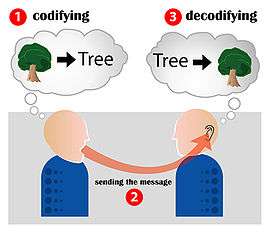Biocommunication (science)
In the study of the biological sciences the general term biocommunication is used to describe specific types of communication within (intraspecific) or between (interspecific) species of plants,[1] animals, fungi, and microorganisms.[2][3] Communication means sign-mediated interactions following three levels of (syntactic, pragmatic and semantic) rules. Signs in most cases are chemical molecules (semiochemicals). Biocommunication of animals[4] may include vocalizations (as between competing bird species), or pheromone production (as between various species of insects),[5] chemical signals between plants and animals (as in tannin production used by vascular plants to warn away insects), and chemically mediated communication between plants[6][7] and within plants. Biocommunication of fungi demonstrates that mycelia communication integrates interspecific sign-mediated interactions between fungal organisms soil bacteria and plant root cells without which plant nutrition could not be organized.[8]
Biocommunication, Biosemiotics and Linguistics
In the study of linguistics, biocommunication theory may be considered to be a branch of biosemiotics. Accordingly, syntactic, semantic, and pragmatic aspects of biocommunication processes are distinguished.[9] Biocommunication specific to animals (animal communication) is considered a branch of zoosemiotics.[10] The semiotic study of molecular genetics, can be considered a study of biocommunication at its most basic level.[11] Current research demonstrated that genetic content arrangements in most cases are the result of competent natural genetic engineering and natural genome editing.[12] According biocommunication theory this requires consortia of agents that edit genomes coherently with insertion/deletion capabilities. Additionally such agents must be capable of de novo generation of new nucleotide sequences and insertion in pre-existing (host)sequences without disturbing/destroyed previous genetic content arrangements. This fundamentally contradicts former narratives in which genetic content arrangements resulted out of error replication events by chance and their selection.[13]
See also
- Animal communication
- Biosemiotics
- Chemotropism
- Ciliates
- Cognition
- Fungus
- Human–animal communication
- Molecular genetics
- Plant perception (physiology)
- Plant physiology
- Slime mould
- Zoosemiotics
- Virus
Notes
- ↑ Witzany G, Baluska F (2012). (eds). Biocommunication of Plants. Springer. ISBN 978-3-642-23523-8.
- ↑ Witzany G, Nowacki M (2016). (eds) Biocommunication of Ciliates. Springer Science + Business Media. ISBN 978-3-319-32211-7
- ↑ Witzany, G (2011). (ed). Biocommunication in Soil Microorganisms. Springer. ISBN 978-3-642-14511-7.
- ↑ Witzany, Guenther (2014). Biocommunication of Animals. Dortrecht: Springer. ISBN 978-94-007-7413-1.
- ↑ Ananthakrishnan, T (1998). Biocommunication in Insects. Science Publishers Inc. p. 104. ISBN 1-57808-031-2.
- ↑ Taiz, Lincoln; Eduardo Zeiger (2002). "Plant Physiology Online". a companion to Plant Physiology, Third Edition. Sinauer Associates. Archived from the original (HTTP) on December 7, 2006. Retrieved 2006-12-26.
- ↑ Farmer, EE; CA Ryan (1990). "Interplant Communication: Airborne Methyl Jasmonate Induces Synthesis of Proteinase Inhibitors in Plant Leaves". Proceedings of the National Academy of Sciences. National Academy of Sciences USA. 87 (19): 7713–7716. doi:10.1073/pnas.87.19.7713. PMC 54818
 . PMID 11607107. Retrieved 2006-12-31.
. PMID 11607107. Retrieved 2006-12-31. - ↑ Witzany, G (2012) (ed). Biocommunication of Fungi. Springer, Dortrecht. ISBN 978-94-007-4263-5.
- ↑ Tembrock, Günter 1971. Biokommunikation: Informationsübertragung im biologischen Bereich. Berlin: Akademie-Verlag.
- ↑ Sebeok, Thomas (ed.) 1977. How Animals Communicate. Bloomington: Indiana University Press.
- ↑ Emmeche, Claus; Jesper Hoffmeyer (1991). From Language to Nature - the semiotic metaphor in biology. Semiotica 84 (1/2): 1-42, 1991. Archived from the original on October 14, 2006. Retrieved 2006-12-31.
- ↑ Witzany G. (ed) (2009) Natural Genetic Engineering and Natural Genome Editing. Annals of The New York Academy of Sciences, Vol. 1178. ISBN 978-1573317658
- ↑ Witzany G. (ed) (2015) DNA Habitats and Their RNA Inhabitants. Annals of The New York Academy of Sciences, Vol. 1341. ISSN 0077-8923
